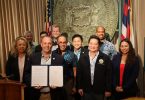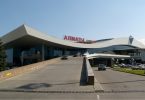WASHINGTON — The new Capitol Visitor Center opened this month as a shrine to the legislative branch, presenting a polished version of Congress that leaves little room for cynicism – though plenty of space for bathrooms.
It arrived four years late and more than $300 million over budget, causing some lawmakers to fume and the Government Accountability Office to offer countless oversight reports and hours of critical testimony. Taxpayer watchdog groups called the center a boondoggle, and some critics worry that the center is another step in trying to keep legislators away from the public.
“I think it’s a monstrosity,” said Rep. Jack Kingston, a Georgia Republican. “It confirms what so many people believe about Washington excess.”
However, tourists who wandered its cavernous space early this month praised the center. They marveled at the 11-foot replica of the Capitol dome and leaned close to study the plaster model of the Statue of Freedom that sits atop the real dome.
On the center’s second day, pupils from three fifth-grade classes from Greensboro, N.C., showed up in matching red sweatshirts, carrying digital cameras and craning their necks toward the skylight in towering Emancipation Hall. A few tired pupils slumped to the polished floor and were quickly roused by Capitol police officers.
“I think the center is just fabulous,” said Donna Shapiro, a fifth-grade teacher at Jesse Wharton Elementary School in Greensboro. “It is worth it. All the children are so excited that we get to see a new part of the Capitol.”
The center was conceived in the 1990s as an indoor stopping place for tourists who’d long suffered in long lines outdoors through the cold of winter and humid summer swelter on their way inside to tour the Capitol itself.
Senate Majority Leader Harry Reid, D-Nev., in his remarks at the center’s opening Dec. 2, said the visitor center would do its job to protect lawmakers from visitors’ sweat glands.
“In the summertime, because it gets so hot in here, you could smell the tourists coming,” Reid said.
The project broke ground ceremoniously in 2000, though construction didn’t begin until 2002. Over the years, members of Congress just kept adding on. There were security updates in the wake of the shooting deaths of two U.S. Capitol police officers in 1998 and the Sept. 11 terrorist attacks.
By the time the first tourists poured inside on its first day, the cost of the Capitol Visitor Center had more than doubled, to $621 million. More than just an air-conditioned underground sanctum, it features 26 restrooms, a restaurant and two gift shops, and encompasses 580,000 square feet of space – more than a third of the Capitol itself.
“It’s beautiful. I think it’s money well spent,” said Covie Herrera, 68, of Santa Teresa, N.M. “If they’re going to spend money, make it for the people. And this is for the people.”
Tourists descend below the Capitol’s east front and enter the great Emancipation Hall, where they can look up at the real Capitol dome through skylights and can wait to begin a 13-minute introductory movie in one of two theaters, with showings assigned to the minute.
“It’s spectacular,” said Ron Sellon of Boston, in town with his wife and two children, ages 5 and 7. “We’ve heard horror stories about the lines before and the uncomfortable waiting. This is just amazing.”
Behind the giant hall, a darkened room holds the Wall of Aspirations – curving marble walls housing original and copies of historic documents, including the Medicare Act of 1965 and James Madison’s 1789 notes on the Bill of Rights.
Visitors also can watch films on the workings of the House and Senate, during which they can hunt for glimpses of their own representatives and hear about the chambers’ collegiality and how members serve the public.
“A lot of it has as much to do with congressional ego as it has to do with the needs of their constituents,” said Steve Ellis, vice president of Taxpayers for Common Sense, a watchdog group in Washington.
Adding to the cost overruns, conservative lawmakers insisted on changes that included engraving the Pledge of Allegiance and the national motto, “In God We Trust,” in prominent locations.
Leaning over the second-story railing on the center’s opening week, David Payne, a superintendent with the New York construction company that worked on the security system, clutched floor plans and proclaimed the center a success.
“We did a good job,” said Payne, who helped with door locks, metal screening and other security projects over the past two months. He was there to review final details.
Payne called the criticism about cost overruns “greatly exaggerated” and said it mostly had to do with new House and Senate offices unavailable to the public.
“They’ve got a whole ‘nother city over there,” Payne said, waving his hand toward the closed doors marked “authorized persons only.”
“There’s a lot of area that’s for the use of Congress. There’s more of that than there is for the public.”
Office space on the House side includes a two-story hearing room with a three-tiered dais but no space for the public. On the Senate side, a spiraling staircase leads downstairs. Somewhere back there is a high-security room for lawmakers to review top-secret documents.
Nearby, a new tunnel leads directly to the Library of Congress.
“You know how many times a day members of Congress go to the Library of Congress to research our speeches?” Kingston quipped.
He and other critics still aren’t happy with the Capitol Visitor Center. And some fear it could become an excuse for Congress, in the name of security, to keep the public out of the Capitol itself.
“The destination should be the Capitol, not the Capitol Visitor Center,” Ellis said. “My concern is that the visitor center will become an impediment to visiting the Capitol.”
For now, it’s the first stop on the larger tour of the Capitol.
The Greensboro students saw the movie and put on headphones to hear their guide, but what many remembered afterward was the Capitol itself, with the old Senate chamber, the tiled floors and the frieze in the rotunda.
“The rotunda – it’s really cool,” said Ryan Daw, 10. “The pictures, it really does look like they’re bumped out.”
That fascination with history is what members of Congress hope to see in their constituents, said Rep. G.K. Butterfield, a North Carolina Democrat who attended the center’s opening ceremony.
“I’m sorry it took $600 million to get it completed. … But it makes a very powerful statement about the U.S. Capitol,” Butterfield said. “There is a history to this body that must be honored.”
IF YOU GO
-The Capitol Visitor Center is open 8:30 a.m. to 4:30 p.m. Monday through Saturday. It will be closed on Jan. 20, Inauguration Day.
-It is on the east side of the Capitol, at First and East Capitol streets NE, accessible by way of 10- to 15-minute walks from the Metro’s Union Station and Capitol South stations.
-Admission to the Visitor Center is free, but visiting the U.S. Capitol itself requires a ticket and tour participation. The Visitor Center recommends making advance reservations through www.visitthecapitol.gov or 202-226-8000. Visitors also can call their U.S. representatives or senators for a staff-led tour.
– There are plenty of public restrooms and a new restaurant open to visitors.






















